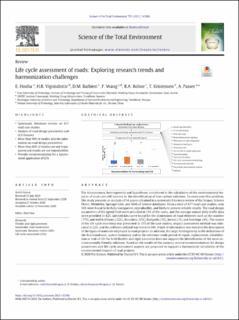| dc.description.abstract | The transparency, heterogeneity and hypotheses considered in the calculation of the environmental impacts of roads are still barriers to the identification of low-carbon solutions. To overcome this problem, this study presents an analysis of 94 papers obtained in a systematic literature review of the Scopus, Science Direct, Mendeley, Springer Link, and Web of Science databases. From a total of 417 road case studies, only 18% were found to be fully transparent, reproducible, and likely to present reliable results. The road design parameters of the speed limit were provided in 11% of the cases, and the average annual daily traffic data were provided in 42%. Limited data were found for the dimensions of road elements such as the number (77%) and width of lanes (33%), shoulders (15%), footpaths (5%), berms (1%) and foreslope (4%). The source of the life cycle inventory was presented in 57% of the case studies, impact assessment method was indicated in 22%, and the software utilized was listed in 50%. A lack of information was noted in the description of the types of materials employed in road projects. In addition, the large heterogeneity in the definitions of the functional unit, system boundary and in the reference study period of repair, replacement, rehabilitation or end-of-life for both flexible and rigid pavement does not support the identification of the most environmentally friendly solutions. Based on the results of the analysis, several recommendations for design parameters and life cycle assessment aspects are proposed to support a harmonized calculation of the environmental impacts of road projects. | en_US |

